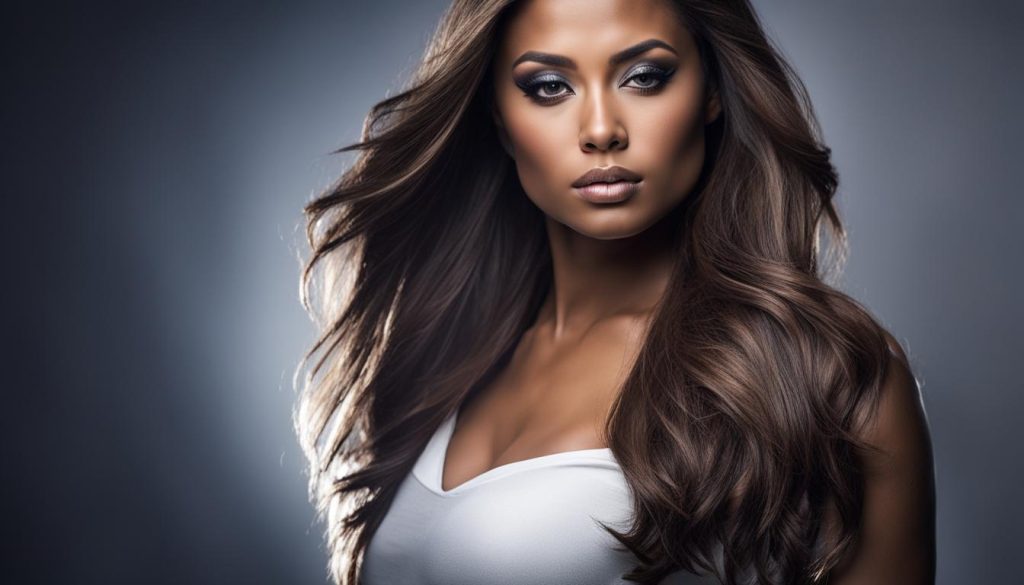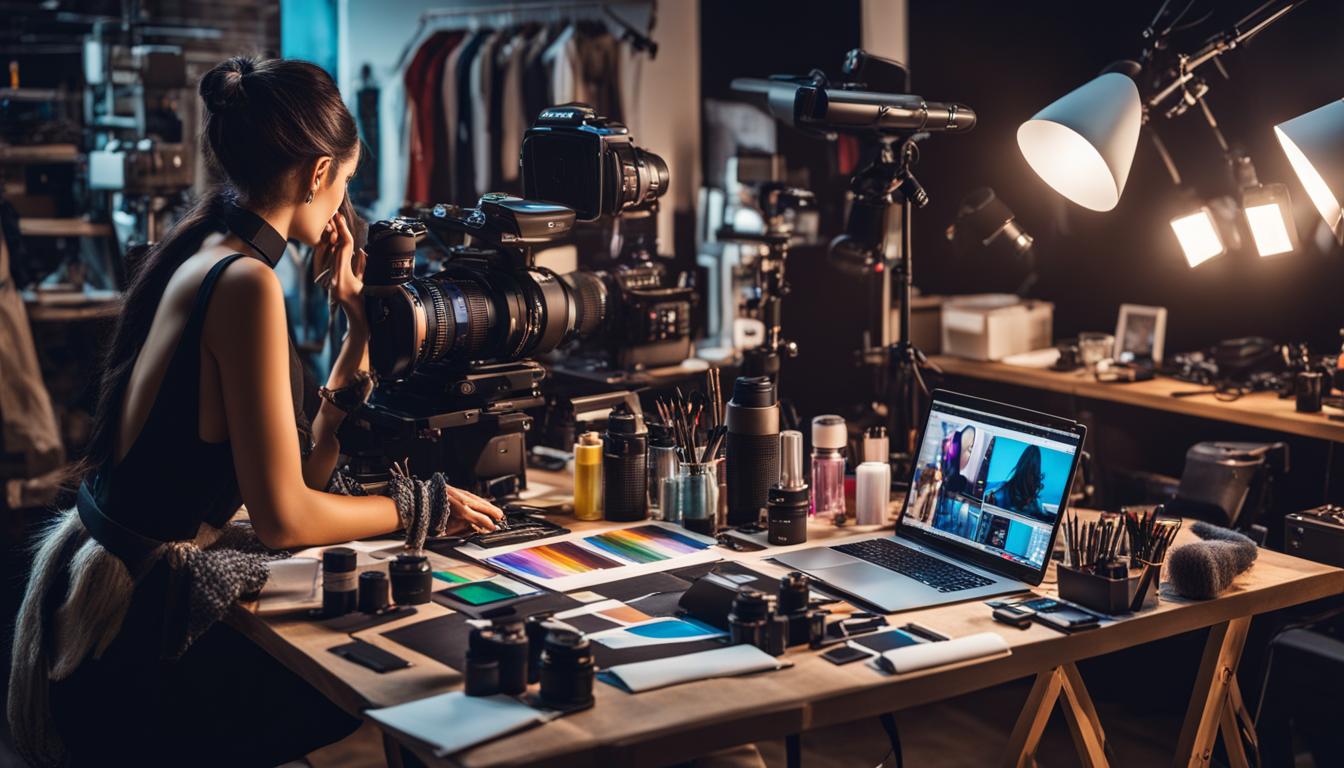If you’re a professional fashion photographer, you know that preparation is key to a successful shoot. With so many moving parts involved, it’s easy to forget something important. That’s why we’ve put together this essential fashion photography checklist to help you stay organized and ensure you’re ready to capture stunning fashion images.
From equipment to wardrobe selection and posing, this checklist covers all the must-have elements for pro shoots and will help you elevate your fashion photography game.
Key Takeaways:
- Prepare a comprehensive checklist before each fashion photography shoot
- Understand the importance of selecting the right equipment for fashion photography
- Pay attention to styling and wardrobe selection for visually interesting images
- Think critically about pose and direction to create dynamic and captivating photographs
- Post-production and editing can make all the difference in enhancing your fashion images
Choosing the Right Equipment
Investing in the right equipment is crucial for achieving outstanding results in fashion photography. From cameras and lenses to lighting and accessories, each piece of equipment plays a crucial role in capturing stunning fashion images.
Begin by selecting a camera that suits your style and preferences. Full-frame cameras, such as the Nikon D850, Canon EOS R5, or Sony A7R IV, allow for high-quality image resolution and optimal low-light shooting.
When it comes to lenses, prime lenses are the preferred choice in fashion photography for their sharpness and wide apertures. Consider investing in a 50mm or 85mm prime lens for stunning portraits, or a wide-angle lens for capturing full-length fashion shots.
Proper lighting is also essential for fashion photography. Studio strobes, softboxes, and reflectors can help control and modify lighting for optimal results. And don’t forget about accessories like tripods, light meters, and memory cards, which are essential for every photographer.
By selecting the right equipment, you’ll have the essential tools needed to create beautiful fashion images.
Planning the Shoot Location
Choosing the right shoot location is paramount in fashion photography. Your location sets the tone for your images and can make or break the overall quality of your shoot.
When planning the shoot location, consider the style of the clothing, the mood of the shoot, and the story you want to tell.
Scout locations that match your vision, and don’t be afraid to book multiple locations for a single shoot. When selecting locations, make sure to take note of natural lighting and potential backdrops. Natural lighting can significantly enhance your photos, while a stunning backdrop adds depth to your images.
“Selecting the perfect location requires careful planning to get the intended narrative across. It’s a process that can make your photography stand out and take it to the next level.”
Styling and Wardrobe Selection
Styling and wardrobe selection play a crucial role in fashion photography. Collaborating with a stylist can save time and ensure that the outfits are on-trend and complement the concept of the shoot. It’s essential to select the right outfits and accessories that align with the brand’s message and the photographer’s vision.
When planning the wardrobe for the shoot, consider the location, lighting, and model’s skin tone to choose colors and textures that enhance the overall look of the photo. Accessories can add depth and interest to an outfit, so don’t be afraid to experiment with jewelry, hats, and scarves.
An excellent way to make sure that the outfits work well together and tell a cohesive story is to create a mood board. Compile images of clothing, accessories, and other inspiration that align with the concept of the shoot. This helps the photographer, stylist, and other team members understand the overall look and feel of the shoot.
Getting the right styling and wardrobe selection can elevate the impact of the fashion photograph, and that’s why it’s essential to pay close attention to every detail when it comes to clothing and accessories.
Effective Posing and Direction
Posing and direction play a crucial role in creating stunning and dynamic fashion imagery. As a fashion photographer, it is essential to communicate and direct the model to capture the desired poses that enhance the clothing and accessories being showcased.
To achieve effective posing, it’s crucial to establish a friendly and comfortable rapport with the model from the onset. This allows you to provide clear and concise directions, positioning, and movement suggestions, giving the model confidence that they’re on the right track. Remember to always give positive feedback to keep the model motivated and feeling confident throughout the shoot.
Another technique to effective posing and direction is to use props and accessories to create a more natural and relaxed ambiance. For example, a scarf floating in the wind or a hat tilted to the side could elevate the mood and bring life to the shot.
Remember to take into account the silhouette of the clothing and accessories, and plan the poses accordingly. Movement is also important, as it adds dynamism and excitement to the images. Encourage the model to move, turn, and interact with the surroundings, capturing those candid moments that make for stunning fashion photography.
Effective posing and direction are critical aspects of fashion photography that require practice and communication. By implementing these techniques, you’ll be able to capture the perfect poses and achieve dynamic and captivating fashion images.

Preparing a Shot List
A fashion photography shoot demands preparation and attention to detail to get the desired results. As you plan your shoot, it’s important to create a shot list that outlines the key shots, poses, and angles you want to capture during the session.
The shot list serves as a guide, keeping your vision on track and making sure that you capture all the necessary shots. It helps reduce the risk of forgetting vital poses or positions during the shoot, which could result in missed opportunities.
To make an effective shot list, you need to consider different factors such as the location, outfits, and models. You can start by creating lists for each of these variables and then merge them into an ultimate guide.
Include all crucial shots such as full-body, close-up, and medium shots, and practice different poses and angles. This will guarantee that your photo session will be productive and result in professionally taken photographs.
Breaking Down Your Shot List
Dividing your shot list into different categories will make sure that the photoshoot runs smoothly and is time-efficient. It will also make sure that nothing is missed. Some categories you can consider include:
- Location
- Outfit and props
- Model poses
- Lighting and the position of the sun (for natural light photography)
Categorizing your shot list is a practice that will allow your team to stay organized and productive. As you go through your photography shoot, the ticked-off list will serve not only as a reminder but also as an achievement list when all is said and done!
Post-Production and Editing
Once you’ve captured the perfect shots, the next step is post-production and editing. Editing plays a critical role in fashion photography, elevating your images to the next level and giving them a unique visual style.
When it comes to post-production in fashion photography, there are a few techniques you should master. Retouching is one such technique that involves removing blemishes and smoothing out skin tones. While subtle retouching can enhance your images, it’s important not to overdo it, as it can result in unnatural-looking images.
Color grading is another essential aspect of fashion photography editing. This technique involves adjusting the colors and tones in your images to create a consistent visual style. By achieving a cohesive color palette, you can elevate your fashion photography to the level of breathtaking and awe-inspiring.
Consider using presets or customizing your own filters to achieve a distinct look for your fashion photography.
It’s important to note that post-production should never be used as a band-aid for poor photography skills. Rather, it should enhance and elevate the already-stellar images you’ve captured.
Remember that editing is a highly personal process, and different photographers will prefer different techniques and styles. Experimenting with various editing techniques will help you determine your unique style and improve your fashion photography skills.
Conclusion
In conclusion, the fashion photography checklist provided in this article serves as a comprehensive guide for all professional photographers seeking to enhance their fashion imagery. The guide outlines essential equipment, planning and styling considerations, effective posing and direction, and post-production and editing techniques that will enable you to capture stunning fashion images.
With these essential tips, you will be well-equipped to tackle pro shoots with confidence, and produce fashion photographs that stand out in a crowded market. Remember, fashion photography is all about creativity and pushing boundaries, so don’t be afraid to experiment and try new things.
We hope that this article has provided you with valuable insights and inspiration for your future fashion photography endeavors. Keep honing your skills, and always seek to improve your craft, and you will undoubtedly succeed in the dynamic and exciting world of fashion photography!






